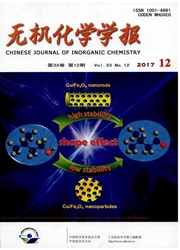

 中文摘要:
中文摘要:
采用无金属四氮杂卟啉与金属盐回流的方法合成了2种四叔丁基四氮杂卟啉配合物,其中四叔丁基四氮杂卟啉铅(Ⅱ)配合物未见文献报道。研究了该2种配合物及其配体的电子吸收光谱行为、热稳定性及在532nm对8ns激光的光限幅特性。结果表明:该类配合物的Q带的最大吸收峰值λmax在570~630nm之间,B带的最大吸收峰值λmax在330—350nm之间,随巾心金属离子不同.Q带吸收峰位置有明显差异;配合物在氮气气氛中的起始分解温度大于250℃,其在热重图上的失重过程对应着4个取代基(-C(CH3)3)的脱去,共轭大环在500℃以下没有分解;它们的光限幅机制属于激发三重态的反饱和吸收(RSA),其中四氮杂卟啉铅配合物具有更强的光限幅效应,这与铅的重原子效应有关。
 英文摘要:
英文摘要:
Two metal tetraazaporphrins including a new tetra-(tert-butyl)-tetraazaporphyrin lead(Ⅱ) were synthesized by refluxing tetraazaporphrin and metal ion. Their electronic absorption spectra, thermal stability, and optical limiting properties at 532 nm for 8 ns pulses were investigated. The Q band maximum absorption peaks (λmax) of them are at 570-630 nm, while the B band maximum absorption peaks (λmax) are at 330-350 nm. The differences of central metal ions have influences on the Q band absorption greatly. The onset decomposition temperature of them are over 250 ℃; the weight loss processes are related to decomposition of four substituent groups (-C(CH3)3), and yet conjugate ring are not decomposed below 500 ℃. The optical limiting mechanism of them is the reverse saturable absorption (RSA) of excited triplet states, and the better optical limiting properties of tetraazaporphrin lead(Ⅱ) compared to the other tetraazaporphrins are attributed to the heavy-atom effect.
 同期刊论文项目
同期刊论文项目
 同项目期刊论文
同项目期刊论文
 期刊信息
期刊信息
